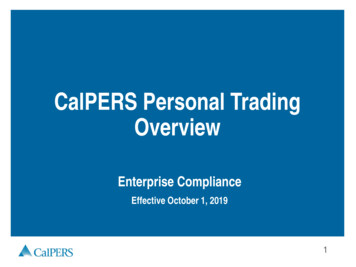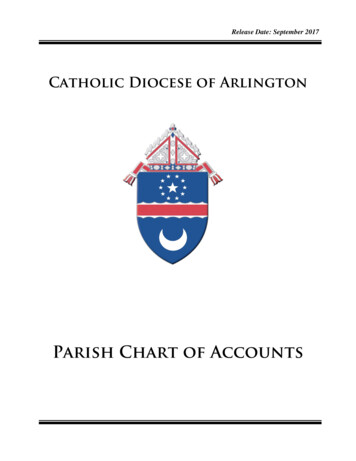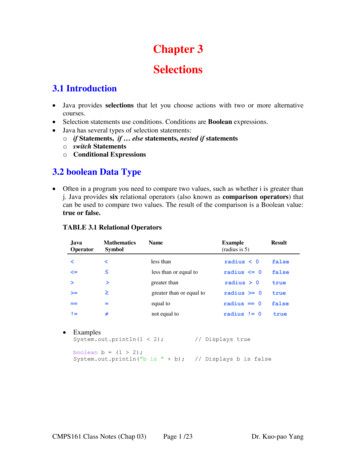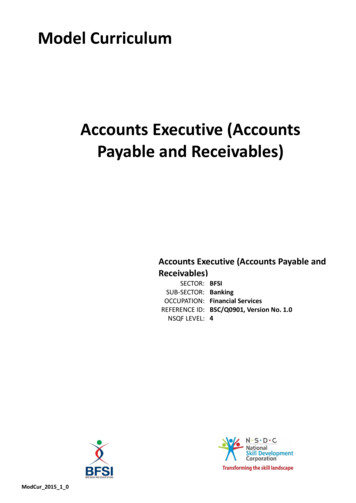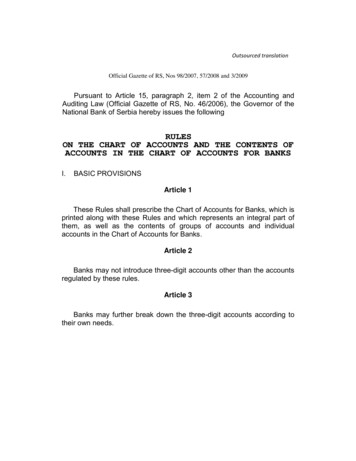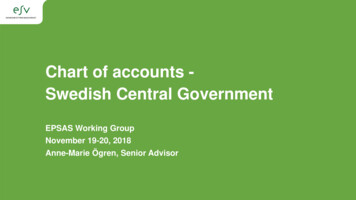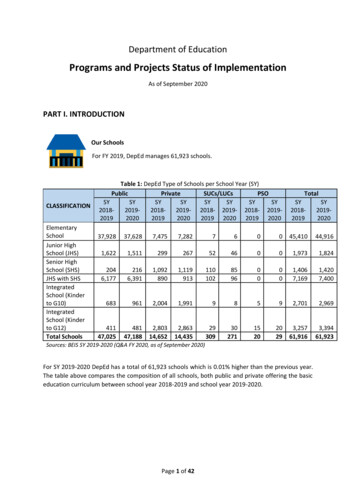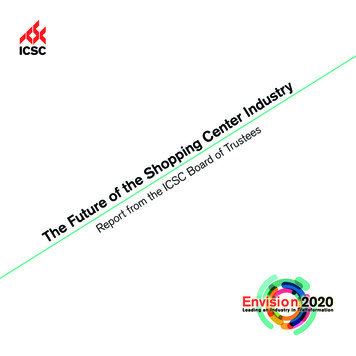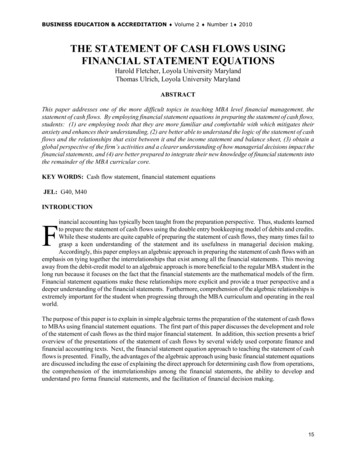
Transcription
1
Contents DescriptionPageNarrative ReportBy the Section 151 Officer3The Statement of ResponsibilitiesExplains the responsibilities of the Council andthe Section 151 for the Statement of Accounts15Auditors ReportSets out the Auditor's opinion on the Statementof Accounts16Comprehensive Income andExpenditure Statement (CIES)Brings together income and expenditurerelating to all of the Council's activities20Movement In Reserves StatementSummarises of the increase/decrease in the networth and resources available to the Council21Balance SheetSets out the financial position of the Council asat 31st March 202022Cash Flow StatementSummarises the movements in assets, liabilitiesand capital which have taken place during theperiod and the impact on cash and cashequivalents23Notes to the Core FinancialStatementsDetailed supporting notes to all of the previousStatements24Housing Revenue Account Incomeand Expenditure StatementShows income and expenditure on the provisionof Council Housing70Movement on Housing RevenueAccount StatementShows the differences between the income andexpenditure and the movement on the HousingRevenue Account balance71Notes to the Housing RevenueAccount Income and ExpenditureStatementsDetailed supporting notes to the HousingRevenue Account Statements72Collection FundShows the income and expendituretransactions of the Council as a billing authorityin relation to the collection and distribution ofCouncil Tax and Non-Domestic Rates78Annual Governance StatementOutlines the contents of the Local Code ofCorporate Governance and the systems ofinternal control operating within the Council81Glossary of Terms88Glossary of Pension-Related Terms96Further copies of this report are available from the Councils website, following the URL 2
Narrative Report1. INTRODUCING EPPING FOREST DISTRICT COUNCILEpping Forest District is in Essex and takes its name from the forest which runs from theGreater London border in the south up through the district northwards. The district alsoshares boundaries with Hertfordshire and four other Essex districts. The district, which isa mixture of rural and urban areas, has a population of 131,137 (as at 2018) and coversan area of 131 square miles. The key population centres are the commuter towns ofBuckhurst Hill, Chigwell and Loughton which are all located in the south of the district andcontain more than half of the population, but only covers 5% of the total area of the district.There are also the market towns of Epping, Waltham Abbey and Ongar and numerousvillages and hamlets which are situated in attractive countryside and are scattered acrossthe remaining 95% of the district. The district has good transport links, with both the M25and M11 running through it and crossing at Theydon Garnon. The area is also servicedby the London Underground Central Line and an over ground rail line.Most of the district is designated within the protective status of the Metropolitan GreenBelt with both Epping Forest and Roding Valley Meadows being sites of special scientificinterest. This brings visitors to the district and tourism generates a substantial amount ofincome for the local economy each year.The residents of the district are considered to be relatively affluent with the averageweekly income for a resident working full time in 2018 being 15.7% higher than theaverage for England. Similarly, the number of residents claiming out of work benefits islower than average. Children tend to be successful with their education; 67.8% of pupilsachieved a “good” passes at GCSE in 2018, which is again higher than the Englandaverage. But the rate of young people attending university was 3% lower than average inthe same year at 47%.Epping Forest is in the upper 40% of least deprived Lower Tier Local Authorities (LTLAs)nationally, although there are areas of deprivation with 12% of children in low incomefamilies. Life expectancy in the district is higher than the national average, but an agingpopulation puts pressure on both NHS and local government services.Within the district, local government services are provided at three levels; by EppingForest District Council, Essex County Council and local Town and Parish Councils. District Council services – Housing, Street Cleansing, Waste Collection andRecycling, Sports and Recreation, Planning Applications, Electoral Registration,Benefit Administration, Council Tax and Business Rates Collection, andEnvironmental Health. County Council services – Education, Social Care, and Highways and Transportation;and Parish and Town Council services – Allotments, Burial Grounds and Cemeteries,Public Halls, and Playgrounds and Sports Grounds.Forecasts suggest that the population of the district will rise significantly over the next 20years. A key factor in this estimated growth is that life expectancy in the district is higherthan the national average and rising; projections indicate that over 55% of the district'spopulation will be aged over 60 by 2020. Additional properties will be built over the comingyears to assist in accommodating the anticipated rise in the population.3
2. PERFORMANCE AGAINST CORPORATE OBJECTIVESA new Corporate Plan for 2018-2023 was adopted in December 2017. The Council hasa duty to secure continuous improvement in a way in which its functions and services areexercised, and as part of that duty a range of Key Performance Indicators (KPIs) relevantto the Council’s service priorities and key objectives are adopted each year.The Year 2 Action Plan (covering 2019/20) represented the second reporting cycle forthe Corporate Plan. Performance measures for Year 2 have been streamlined to enablea sharper focus on how well corporate objectives are being met. This has resulted in areduction of the number of KPIs listed in 2018/19 from 47 to 12, and 11 key corporateprogrammes of work ranked with a “RAG” (Red, Amber, Green) rating reported for eachambition.The Corporate Plan links the key external drivers influencing Council services, with a setof corporate aims and objectives, grouped under three corporate ambitions. Stronger Communities Stronger Place; and Stronger Council.Performance against all KPIs and all key corporate programmes of work is reviewedquarterly. During the year the Stronger Council Select Committee, the Stronger PlaceSelect Committee, the Stronger Communities Select Committee and the Finance andPerformance Management Cabinet Committee have had overview and scrutiny roles toensure continued achievability and relevance, and to identify proposals for appropriatecorrective action in areas of under-performance.The 'Stronger Communities' ambition has three strategic aims supported by six keyobjectives that were delivered from the three key corporate programmes: CustomerExcellence, Insight & Behaviour and delivery of the Epping Forest Health & WellbeingStrategy. During 2019/20, one out of three key programmes was achieved.Five out of eight (62.5%) performance indicators that were measured were achieved. Asummary of the performance during 2019/20 is given below.4
The 'Stronger Place' ambition also has three strategic aims which are supported by sevenkey objectives that were delivered from the four key corporate programmes: Delivery ofthe Council Housebuilding, Local Plan, St Johns Road and Growth/Skills/Employment.During 2019/20, out of the four key programmes of work set, one was achieved. The LocalPlan was delayed due to the requirement for a Habitats Regulation Assessment.One out of two (50%) of performance indicators measured were achieved and the secondone performed within agreed tolerance levels for the indicator.The 'Stronger Council' ambition has four strategic aims supported by six key objectivesthat were delivered from the three key corporate programmes: People Strategy, DigitalEnablement and Accommodation Strategy. During 2019/20, the three key programmesof work set were not achieved. The Accommodation Strategy hit design delays;however, the Council remains on course to complete the overall programme on timein 2020/21. was in delivery is:One out of two (50%) of performance indicators measured, were achieved.5
3. FINANCIAL REVIEW 2019/20At the time of writing, it is hard to ignore or understate the profound financial impact that theCoronavirus (Covid-19) Pandemic has had and will continue to have on local authority financesfor some time yet (see discussion in Note 4 of the main financial statements). However, thefinancial effects really began to bight when the Government imposed a national lockdown from23rd March 2020 i.e. just eight days before the end of the 2019/20 financial year. The impact onthis Statement of Accounts is therefore quite limited, with the following discussion reflecting onthe period April 2019 through to March 2020.The Consolidated Income & Expenditure Statement (CIES) on Page 19 shows that the Net Costof Services for 2019/20 was 26.518 million (up 4.954 million compared to 2018/19); after otherfactors such as the impact of Taxation and other Gains and Losses, including those from the ringfenced Housing Revenue Account, are adjusted for, Total Comprehensive Net Expenditure of 7.119 million was incurred. The primary reason for the increase in Net Cost of Services was adecrease in Net Income from the Housing Revenue Account of 4.203 million (explained below).The presentation of individual services (“Continuing Operations”) on the face of the CIES followsthe principles established in CIPFA’s “Service Reporting Code of Practice for Local Authorities(2019/20)” (SERCOP); consistency of reporting is achieved with the internal managementaccounts, which reflect how services are delivered and organised within the Council.Although overall Net Expenditure across the services in 2019/20 is generally consistent comparedto 2018/19, there are some fluctuations (both up and down) between the two years, reflectingchanging local circumstances including a senior management restructure (affecting the ChiefExecutive’s cost centres), fluctuating asset values (in particular, an increase in value of a specificasset affecting a Commercial & Regulatory cost centre this year) and continuing local initiativessuch as the Local Plan and the Garden Town initiative (combining to increase net expenditure onPlanning Services).However, the CIES reflects a vast range of adjustments required by both statute and accountingstandards. Underlying the figures, is the performance of the Council’s General Fund and HousingRevenue Account in the year.General FundThe table below reflects the Month 12 (year-end) Management Accounts for 2019/20.Net ExpenditureBudgetOutturn 000’s 000’s3,7634,773General Fund ServiceBusiness SupportVariance 000’s1,010Community & Partnerships3,7653,438(327)Commercial & Regulatory(4,014)(4,485)(471)Contracts & Technical6,9437,057114Customer Services4,7824,79412Housing & Property522435(87)Planning4,3003,555(745)Chief Executive2,5742,159(415)Totals22,63521,727(908)6
The Month 12 Accounts show that the General Fund budget was in surplus by 908,351. Thereare a wide range of budget variances – both positive and negative – underlying the surplus; themost significant service variance relates to Business Support, which was overspent by 1.010million. The single largest factor in the overspend was the need to set aside additional contingencyfunds within the corporate Bad Debt Provision ( 515,410) because of the pandemic (a slightlylarger budget surplus was anticipated during the year; this was an entirely unforeseen event ofmajor significance).Housing Revenue Account (HRA)The table below summarises the outturn on the HRA for 2019/20 compared to 2018/19.2019/20 000’s2018/19 000’sVariance 000’sTotal Expenditure33,17427,9875,187Net Cost of Services (included in CIES)(1,225)(5,642)4,417Other costs and accounting adjustments4,2704,156114(Surplus)/Deficit for DescriptionTotal Income(34,399)Reconciling adjustments (including reversals)(Increase)/Decrease in HRA Balance(33,629)(770)A higher than anticipated Depreciation requirement ( 501,000) in the year led to the (legislative)requirement to contribute a total of 8.579 million to the Major Repairs Reserve (MRR). Thismeant that a planned contribution of 0.5 million to the Self-Financing Reserve was no longerviable without reducing the minimum balance assumed within the 30-Year HRA Business Plan.In addition, there was a notable accounting adjustment required following a downward revaluation(“Impairment”) of Council Dwellings and Garages of 7.62 million, which compared to acorresponding adjustment of 2.351 million in 2018/19. This further increased expenditure in theyear, but – in accordance with proper accounting practice – the effects are reversed out todetermine the actual HRA balance (available to support future spending).Overall, the HRA balance marginally reduced (partly due to an additional provision of 140,000made to the Bad Debt Provision, due to Coronavirus) from an opening position of 2.315 million,to close at 2.030 million at the year end.Collection FundThe Collection Fund recorded an overall Deficit for 2019/20 of 5.013 million. Whilst collectionrates for Council Tax and Business Rates held up in the year and the Council continued to benefitfrom the Essex Council Tax Sharing Agreement (Benefit 577,000) and the Essex BusinessRates Pool (Benefit 324,000), theses were more than offset by other (exceptional) factors. Thus: Council Tax (2019/20 Deficit 1.215 million) – the Epping share of the recorded Deficit is 106,000. The most notable factor was the need to significantly increase the Bad DebtProvision this year ( 1.899 million Collection Fund charge, compared to 0.234 million in2018/19), with the most notable factor being the impact of Covid-197
Business Rates (2019/20 Deficit 3.798 million) – the Epping share of the recorded Deficit is 1,519,200. The most notable factor was a loss of a major Appeals case in the year, whichused all of the previously set-aside provision for this purpose. The Collection Fund chargefor Appeals was therefore 2.224 million, compared to 0.226 million in 2018/19. As withCouncil Tax, additional provision for Bad Debts was required due to the impact of Covid-19( 0.706 million Collection Fund charge, compared to 0.110 million in 2018/19).Despite the deficits recorded this year, the Collection Fund still retained an overall Surplus as at31st March 2020 of 1.675 million (Council Tax 0.175 million, Business Rates 1.499 million).Balance SheetThe Council's Balance Sheet value has been very stable in 2019/20, with a marginal increase ofjust 7.3 million (1.1%) on the net position as at 31st March 2020. However, there some significantdifferences compared to 2018/19 as follows: Investment Properties (up 21.0 million) – there Council acquired new Commercial Assetswith a total value of 25.2 million in 2019/20, which is the primary reason behind the increasedin value on the Balance Sheet in this area Short-Term Temporary Investments (down 16.0 million) – investments were graduallyredeemed during the year as the Council moved towards a planned borrowing position on itsGeneral Fund Cash & Cash Equivalents (up 21.6 million) – short-term borrowing of 14.0 million in lateMarch 2020 to meet anticipated cash flow requirements expenditure in April 2020 wasprimarily the reason for a brief spike in cash holding, although maintaining higher cashholdings generally has been a deliberate strategy since the outbreak of the pandemic (againstthe added backdrop of exceptionally low interest rates) Long-Term Loans (up 25.0 million) – planned borrowing from the PWLB to finance the needsof the Council’s General Fund Capital Programme saw Long-Term Loans on the BalanceSheet rise from 185.5 million to 210.5 million in the year.Usable ReservesThe overall balance on Usable Reserves declined slightly from 48.266 million to 47.535 millionover the year.The General Fund (unallocated) balance began the year at 7.437 million and ended the year at 7.759 million The increase on the balance was due to a combination of factors. Notably: A surplus on the General Fund Budget of 0.908 million (referred to above), was added toby a net surplus on funding and other adjustments of 0.261 million (resulting in a netincrease of 1.169 million before Transfers to Earmarked Reserves); this was partially offsetby Net transfers of 0.847 million to Earmarked Reserves. This included a net transfer of 0.495million to the District Development Fund (“DDF”).8
Earmarked Reserves were also relatively stable this year: District Development Fund (DDF) – a long established reserve to meet expenditure onpriorities of a one-off or temporary expenditure ended the year with a balance of 1.371million (down by 1.049 million compared to 31st March 2019) as a number of priorityprojects were advanced during the year; the largest spending item was the Local Plan( 0.649 million). The year-end balance contains the funds necessary to finance all futurecommitments including for example, the annual Police Contribution for 2020/21 and 2021/22( 0.430 million). It also includes funding of 0.229 million for DDF projects rolled forwardfrom 2019/20. DDF commitments established in 2020/21 (e.g. in response to the pandemic)will require a future transfer from the General Fund balance noted above; and Invest to Save (ITS) – a reserve earmarked for projects usually of a transformational nature.This was dormant in 2019/20 and retained its balance of 0.292 million; due to delays incommitted projects such as planned capital works at Vere Road Car Park.Three new reserves with a combined value of 1.546 million were also created at year end. Thisimproves transparency and clarity, especially in the case of the Garden Town project which is ajoint partnership with East Hertfordshire District Council and Harlow Borough Council; the yearend balance of 0.537 million represents the Epping Forest District Council share of funds.Unusable ReservesThe Council is required to maintain substantial Unusable Reserves, primarily for technicalaccounting purposes. The overall balance rose slightly from 601.4 million to 606.4 million overthe year. Most notably - despite the pandemic – the Council’s Pension Liability actually fell at theyear end.The Pension Reserve (liability) reduced from 69.848 million to 63.637 million. This was primarilydue to a reduction in estimated Defined Benefit Obligations of 14.7 million outweighing adecrease in the estimated Fair Value of the Fund Assets of 8.8 million. The two largest factorswere: Obligations – there was a substantial change in financial assumptions based on marketconditions as at 31st March 2020. In particular, both future pensions and salary increaseswere expected to be lower compared to the same stage in 2019. Revised financialassumptions reduced estimated Obligations by 22.2 million; and Assets – the turmoil caused on financial markets near the year end as a consequence of thepandemic led to a significant reduction in investment returns, with a loss on assets (afterinterest) of 12.2 million recorded.CapitalThe table below summarises the Capital Expenditure outturn for 2019/20.2019/20 000s2018/19 000sHousing Revenue Account (HRA)17,33617,354Total Capital Programme43,71527,511DescriptionGeneral Fund26,377910,157
It can be seen that it was a very stable year for HRA Capital Expenditure with expenditure just 96,000 lower than planned. There were some minor underlying variances, most notably withadditional expenditure required on Structural Schemes due to the age of some properties andtree root damage ( 688,000) being broadly matched by some slippage on Housing Developments(especially Phase 4) of 640,000.It was a larger General Fund Capital Programme this year as the Council increased its investmenton its priorities within the Corporate Plan 2018-2023. The increase was primarily due to theplanned acquisition of Commercial Assets from a total budget of 30.0 million (the objective beingto “achieve financial independence with low Council Tax” as part of the “Stronger Council”corporate ambition). The Loughton & Centric Development was acquired at a cost of 19.8 million,with 90 Brooker Road also acquired for 5.3 million. The unspent balance ( 4.8 million) has beenrolled forward into 2020/21 and is available for future potential investment opportunities as theyarise.10
4. PRINCIPAL RISKS AND UNCERTAINTIESA Risk Management Strategy is in place to identify and evaluate risks. There are clearly definedsteps to support better decision making through the understanding of risks, whether a positiveopportunity or a threat and the likely impact.Annually the Chief Internal Auditor gives their opinion on the adequacy and effectiveness of theCouncil’s governance, risk management arrangements and control processes. For 2019/20 thesewere found to be adequate and effective. During 2019/20 at the committee level formalresponsibility for risk management was transferred over to the Audit and Governance Committeefrom the Finance and Performance Management Cabinet Committee. The Audit and GovernanceCommittee receive regular updates on the Corporate Risk Register and given the opportunity tocomment and suggest changes.The top risks from the Council's Corporate Risk Register as at June 2020 are listed below:Top Risks IdentifiedRiskThe Council does nothave an adopted LocalPlan.Welfare reformchanges have adetrimental effect onthe Council and thecommunityImpactPotential loss of strategicplanning control; vulnerability toplanning appeal decisions.Increases in rent arrears,Council Tax arrears, evictionsand homelessness, costs oftemporary accommodation,public dissatisfaction and loss ofincome for the Council.MitigationEngagement with stakeholders.Modifications to Local Plan inprogress.Cross-service and sector workinggroup established to assess impactsof the introduction of Universal Creditand an action plan to mitigate theeffects.Failure to achievestrong economicdevelopmentUnable to secure enoughopportunities; local area andpeople lose out; insufficientinward investment; impact oneconomic vitality of area; loss ofrevenueAn Economic Strategy and action planhave been developed which contain arange of optionsBusiness Continuity Inability to functionshould a significantevent occurServices disruption / loss ofservice, possible loss of income;staff absence, hardship forsome of the community. Councilcriticised for not respondingeffectivelyCorporate business continuity plan,which has been tested. Underpinnedby departmental plans.Delays in issuingPlanning Permission fordevelopment due to theimpact on air quality inEpping Forest SpecialArea of ConservationDelays in getting an adoptedLocal Plan in place; loss of NewHomes Bonus; restrictedBusiness Rates tax base growthRegular meetings with keystakeholders including NaturalEngland. Interim mitigation strategyhas been agreed by Council. Draft AirQuality Strategy developed.Lack of response to theclimate emergencyFailure to achieve identifiedcarbon reductiontargets/actions.A Climate Change Officer has beenappointed together with a SustainableTransport Officer, and an action planwill be developed.Failure to successfullydeliver the Council’sTravel PlanIf staff are unable to travelflexibly it could impede thedelivery of the Council’sAccommodation Strategy.Staff engagement through the TravelPlan survey and key messagesdelivered through staffcommunications11
Covid-19 and recoveryfrom it prevents theCouncil providingservices and achievingits objectivesLoss of income and increasedcosts; economic downturn;greater demand on Councilservices; risk of the Council’scontractors not surviving thecrisis; workforce ability to worksafely; reliance on IT, especiallyfor staff working remotely; risk ofcyberfraud; risk to the successof Quails; responding to centralgovernment Covid-19 initiatives.12Covid-19 Health &Safety riskassessments; variety of recoveryplans in place; central governmentfunding; higher levels of Councilreserves and balances; keepingabreast of government initiatives;regular reviews and monitoring ofcontracts; cybersecurity measures andIT Disaster recovery plan in place.
5. EXPLANATION OF THE ACCOUNTING STATEMENTSThe Statement of Accounts shows the financial performance for 2019/20 and the financial positionas at 31st March 2020. They present the income and expenditure for the year and highlight anysignificant changes in the Council’s financial position during the year.The document comprises Core and Supplementary Statements, together with Disclosure Notes.The format and content of the financial statements is prescribed by the CIPFA Code of Practiceon Local Authority Accounting in the United Kingdom 2019/20 (“the Code”), which is underpinnedby International Financial Reporting Standards (IFRSs).The Code requires that the Statement of Accounts give a true and fair view of the financial positionof the Council and are prepared on the basis that the Council is a going concern.In line with the Code, suitable accounting policies have been applied, and where necessary,prudent judgements and estimates have been made.The Statement of Accounts can be ‘technical’ and complex, but – wherever possible –information is presented as simply and clearly as possible to assist the understanding of users.This Narrative Report explains the purpose and meaning of the Core (main) Statements belowand then goes on to provide a summary of the Council's financial performance for the year2019/20.The Core Financial Statements are:Comprehensive Income and Expenditure Statement (CIES)This records the Council’s income and expenditure for the year. It can be broken down into twoparts. The top part of the statement shows the accounting cost of providing the Council's services.The costs have been grouped into service areas based on the way in which the Council managesand monitors it services' spending throughout the year. This results in a Surplus or Deficit on theprovision of services for the year. The bottom part of the statement is where gains and lossesrelating the measurement of the Council's assets and liabilities are shown i.e. within OtherComprehensive Income and Expenditure.Movement in Reserves Statement (MiRS)This summarises movements that have taken place during the year between the Council'sdifferent reserves. The Statement shows the split between 'usable' reserves, i.e. those that canbe used to fund expenditure and/or reduce local taxation; and other 'unusable' reserves i.e. thesereserves are for specific purposes and cannot be spent.Balance SheetThis is a "snapshot" of the Council's assets, liabilities, cash balances and reserves at the yearend date. The net assets (assets less liabilities) of the Council are matched by the reserves heldby the Council.Cash Flow StatementThis shows the reasons for changes in the Council's cash balances during the year, and whetherthat change is due to operating activities, new investment, or financing activities (such as therepayment of borrowing and other long-term liabilities). The cash flow statement also includes"cash equivalents" which are short-term investments that are subject to only insignificant risks ofchanges in value.13
The Supplementary Financial Statements are:Annual Governance StatementThis sets out the governance structures of the Council and its key internal controls.Housing Revenue Account (HRA)This separately identifies the Council's statutory landlord function as a provider of social housingunder the Local Government and Housing Act 1989.Collection FundThis summarises the collection of council tax and business rates, and the redistribution of thatmoney to other local authorities and central Government.The other notes to these financial statements provide more detail about the Council's accountingpolicies and individual transactions.14
STATEMENT OF RESPONSIBILITIES FOR THE STATEMENT OFACCOUNTTHE AUTHORITY'S RESPONSIBILITIESThe Authority is required to: Make arrangements for the proper administration of its financial affairs and to secure that oneof its officers has the responsibility for the administration of those affairs. In this Authority, thatofficer is the Chief Finance Officer (Section 151 Officer); Manage its affairs to secure economic, efficient and effective use of resources and safeguardits assets; and Approve the Statement of Accounts.Councillor Ian HadleyChairman of the Audit & Governance Committee28th September 2020THE SECTION 151 OFFICER'S RESPONSIBILITIESThe Section 151 Officer is responsible for the preparation of the Authority's Statement of Accountsin accordance with proper practices as set out in the CIPFA Code of Practice on Local AuthorityAccounting in the United Kingdom (“the Code”).In preparing this Statement of Accounts, the Section 151 Officer has: Selected suitable accounting policies and then applied them consistently;Made judgements and estimates that were reasonable and prudent; andComplied with the Code of Practice.The Section 151 Officer has also: Kept proper accounting records which were up to date; andTaken reasonable steps for the prevention and detection of fraud and other irregularities.I certify that the accounts set out on pages 3 to 80 give a true and fair view of the financial positionof the Council as at 31st March 2020 and the income and expenditure for the year then ended.Andrew Small CPFAStrategic Director & Section 151 Officer21st August 202015
Auditors ReportINDEPENDENT AUDITOR’S REPORT TO THE MEMBERS OF EPPING FOREST DISTRICTCOUNCILREPORT ON THE AUDIT OF THE FINANCIAL STATEMENTSOpinionIn our opinion the financial statements of Epping Forest District Council (‘the Authority’): Give a true and fair view of the financial position of the Authority as at 31 March 2020 and ofits expenditure and income for the year t
Epping Forest is in the upper 40% of least deprived Lower Tier Local Authorities (LTLAs) nationally, although there are areas of deprivation with 12% of children in low income families. Life expectancy in the district is higher than the national average, but an aging population puts pressure on both NHS and local government services.
